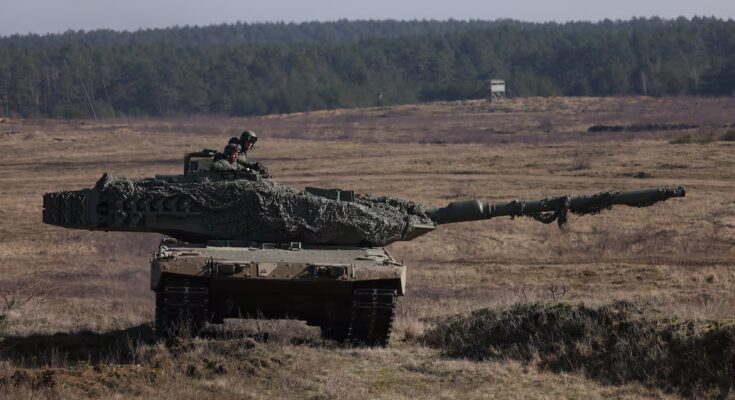There is no point in embarking on the arms and military race that Europe has undertaken in the shadow of the Russian threat if, when an emergency arises, soldiers, tanks or defense systems do not quickly reach the place where they are needed most. And this is what is currently happening in a European Union where permits to move armies across borders can take weeks and even months, lost in bureaucratic tangles, and where many bridges, roads or rail networks are not suitable for heavy and complex military transport. To overcome these problems and have agile forces, the European Commission presents this Wednesday a “military mobility” plan that aims to create a “military Schengen” that facilitates the movement of troops and weapons in the European space.
“You cannot defend a continent if it is not possible to cross it. Solid logistical networks can make the difference between winning and losing a war”, underlined the Commissioner for Transport and Tourism, Apostolos Tzitzikostas, in a meeting with a group of journalists in which he analyzed the proposal that the European Executive will have to formally launch this Wednesday for the analysis of the Member States and the European Parliament.
One of the keys to the plan is to harmonize the rules to streamline the entire bureaucratic process for mobilizing troops from one country to another. “We want to establish very clear rules and procedures for cross-border military movements,” underlines the Greek commissioner. To this end, Brussels proposes, on the one hand, that each country appoint a national coordinator of military transport (currently you have to knock on multiple doors and ministries, a situation that also varies in each state) who acts as a one-stop shop to manage requests of this type.
Furthermore, in peacetime, the Commission proposes to establish by law a maximum period of three days so that the country you wish to cross can indicate whether or not it authorizes the crossing of troops from another state. However, the situation accelerates if an emergency is declared (at the request of a Member State, the Commission will then bring the proposal to the Council, which will have to quickly decide whether to accept declaring this extraordinary situation). In this case, the process of transferring material and especially troops across the border will have to be reduced to a few hours and, in principle, member countries will not be able to reject the request. However, some are under analysis warningsespecially in light of the fact that there are four Member States in which military neutrality exists that could be compromised by these proposals: Austria (the country that raises the most doubts, due to its important geostrategic position), Ireland, Cyprus and Malta.
The “military Schengen”, which states and the European Parliament will have to approve before it can be launched, also includes, among others, the creation of a solidarity fund for military mobility inspired by the EU civil protection mechanism that helps mobilize emergency aid, personnel and material, in the event of disasters, such as forest fires or floods. Likewise, in the military case, this “fund”, created in part with voluntary contributions from participating countries, could make military reserves and related means of transport – trains, ferries, strategic air transport – available to states.
The Commission’s military mobility plan – a proposal for a regulation aimed at harmonizing the often different and disparate national provisions, as well as a communication with multiple lines of action – also contains an important stage dedicated to improving European dual-use infrastructure, both civil and military.
“We need a network of roads, railway networks, ports, airports, tunnels, etc. that meet military requirements, i.e. are suitable to support the loads, weights and dimensions of military equipment,” says Tzitzikostas.
It is not a question, he underlines, of creating a completely new infrastructure, but of “improving” the existing one. To this end, the Greek authorities anticipated, more than 500 projects have been identified – which will be kept secret for security reasons – which are based on the principle of rapid implementation to also rapidly increase capabilities. These are plans such as strengthening road and rail networks, expanding tunnels or expanding ports. The work of identifying projects is carried out in coordination with NATO, to which 23 of the 27 European partners belong, which also committed at the last summit in The Hague to increasing defense spending to 5% of GDP. Part of this percentage, 1.5%, will be allocated to projects related to security in the broad sense and this is where the infrastructure spending that the Commission is now proposing can come into play.
The European Executive’s military mobility plan is known after the devastating report presented at the beginning of the year by the EU Court of Auditors on the subject. The Luxembourg Court of Auditors, in addition to underlining that the budget for this fundamental part of the project of a safer and more capable Europe for which the EU has set itself the 2030 objective, was calculated too low, warned of multiple “bottlenecks”, bureaucratic and infrastructural, which prevent the EU from achieving its objective of “ensuring a rapid and fluid movement of personnel, material and military equipment into and out of the EU at short notice and on a large scale.”
Tzitzikosas assures that these shortcomings have been taken into account. And he points out as proof the strengthening of the budget dedicated to military mobility in the Commission’s proposal for the next multiannual budgets 2028-34: up to 17 billion euros, ten times more than the current budget, which is half exhausted. In total, Brussels estimates that the development of military mobility in the EU will require investments of up to 100 billion euros. But it doesn’t all have to start immediately, not even from a single piggy bank, he underlines. In addition to national budgets, cohesion funds and other European funds can also be used, as well as part of the SAFE loan program of up to €150 billion for joint purchases in the European defense sector.



